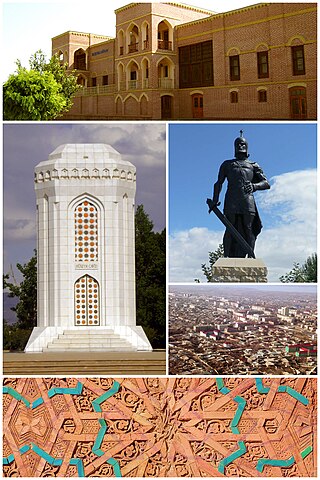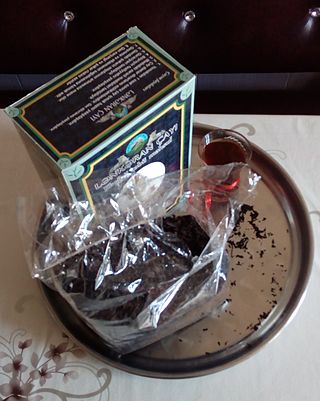
Azerbaijan is a country in the Caucasus region, situated at the juncture of Eastern Europe and West Asia. Three physical features dominate Azerbaijan: the Caspian Sea, whose shoreline forms a natural boundary to the east; the Greater Caucasus mountain range to the north; and the extensive flatlands at the country's center. About the size of Portugal or the US state of Maine, Azerbaijan has a total land area of approximately 86,600 km², less than 1% of the land area of the former Soviet Union. Of the three Transcaucasian states, Azerbaijan has the greatest land area. Special administrative subdivisions are the Nakhchivan Autonomous Republic, which is separated from the rest of Azerbaijan by a strip of Armenian territory, and the Nagorno-Karabakh Autonomous Region, entirely within Azerbaijan. The status of Nagorno-Karabakh is disputed by Armenia, but is internationally recognized as territory of Azerbaijan.

Ujar District is one of the 69 districts of Azerbaijan. It is located in the centre of the country and belongs to the Central Aran Economic Region. The district borders the districts of Agdash, Goychay, Kurdamir, and Zardab. Its capital and largest city is Ujar. As of 2020, the district had a population of 89,500.

Goychay District is one of the 69 districts of Azerbaijan. Located in the centre of the country, it belongs to Central Aran Economic Region. The district borders the districts of Agdash, Qabala, Ismayilli, Kurdamir, and Ujar. Its capital and largest city is Goychay. As of 2020, the district had a population of 121,700. It is famous for its pomegranate growing industry, and for its pomegranate festival.

Shamakhi District is one of the 69 districts of Azerbaijan. It is located in the east of the country and belongs to the Mountainous Shirvan Economic Region. The district borders the districts of Quba, Khizi, Gobustan, Hajigabul, Agsu, and Ismayilli. Its capital and largest city is Shamakhi. As of 2020, the district had a population of 106,400.

Fauna of Azerbaijan or animal kingdom of Azerbaijan refers to the diversity of various types of animals, which inhabit and populate a defined ground or water area in Azerbaijan.

The climate of Azerbaijan is very diverse. Nine out of eleven existing climate zones are present in Azerbaijan.
Azerbaijani cuisine is the cooking styles and dishes of the Republic of Azerbaijan. The cuisine is influenced by the country's diversity of agriculture, from abundant grasslands which historically allowed for a culture of pastoralism to develop, as well as to the unique geographical location of the country, which is situated on the crossroads of Europe and Asia with access to the Caspian Sea. The location has enabled the people to develop a varied diet rich in produce, milk products, and meat, including beef, mutton, fish and game. The location, which was contested by many historical kingdoms, khanates, and empires, also meant that Azerbaijani cuisine was influenced by the culinary traditions of multiple different cultures, including Turkic, Iranian, and Eastern European.

The following outline is provided as an overview of and topical guide to Azerbaijan:

Economy of Nakhchivan covers the issues related to the economy of the city of Nakhchivan, is the most important center of economic activity in Azerbaijan.
Two-thirds of energy in Azerbaijan comes from fossil gas and almost a third from oil. Azerbaijan is a major producer of oil and gas, much of which is exported. Most electricity is generated by gas-fired power plants. Energy is all types of energy products, including fuel, renewable energy, water energy, electrical and heat energy.

Azerbaijani wine is produced in several regions throughout Azerbaijan. Before 20th century communist rule, the region which makes up modern-day Azerbaijan had produced wine since the second millennium BC. The territory of modern-day Azerbaijan has a long history of wine production, that was rediscovered at archaeological digs of settlements in Kültəpə, Qarabağlar
Azerbaijani dialects reflect relatively minor language differences and are mutually intelligible. The Azerbaijani language has two distinct sublanguages: Northern and Southern.
Azersun Holding MMC is an Azerbaijani conglomerate that operates in the food production, retail, and farming sectors primarily in Azerbaijan but also in other CIS countries and the Middle East. Azersun is the largest food producer and exporter in Azerbaijan and also engages in the trade of paper and packaging.

Shaki-Zagatala Economic Region is one of the 14 economic regions of Azerbaijan. It borders Russia to the north and Georgia to the west, as well as the economic regions of Quba-Khachmaz, Mountainous Shirvan, Central Aran, and Ganja-Dashkasan. The region consists of the districts of Balakan, Zagatala, Gakh, Shaki, Oghuz and Qabala. It has an area of 8,840 square kilometres (3,410 sq mi). Its population was estimated to be at 630.4 thousand people in January 2021.
The Azerbaijan is a country with very favorable natural conditions and rich natural resources. Snowy peaks, high mountains, foothill fertile soils, wide plains, Lowest Land Points Below Ocean Level are the main landscape forms of the republic. This complex landscape structure has resulted in a variety of natural conditions, climate, soil-vegetation, and water resources. This, in turn, led to the uneven distribution of population and farms on the territory, and the specialization of production on different types.

The Heydar Aliyev Baku Oil Refinery is an oil refinery located in Baku, Azerbaijan. It is currently the only oil refinery in Azerbaijan, capable of producing about 120,000 barrels (19,000 m3) of refined products per day. The refinery meets the entire domestic demand for petroleum products and exports more than 40% of the products. The plant processes 15 different products including gasoline, diesel, jet fuel, black oil, petroleum coke, asphalt, lubricants etc. It is owned and operated by SOCAR, which is the national oil company of the Azerbaijan Republic.

Tea growing in Azerbaijan is concentrated in an area of 5.33 thousand square kilometers located within the Lenkeran-Astara region, including the districts of Astara, Lankaran, Masalli, Lerik, Yardimli, and Jalilabad. Around 90% of Azerbaijan's tea is produced in Lankaran close to the southern border with Iran. Tea was first grown around the Caspian Sea region of Azerbaijan in the 1880s. Due to its favorable climatic conditions, the region now produces 99% of the Azerbaijani tea crop.

Aran Economic Region was one of the 10 economic regions of Azerbaijan. It bordered Iran to the south, as well as the economic regions of Upper Karabakh, Ganja-Gazakh, Shaki-Zagatala, Mountainous Shirvan, Absheron, and Lankaran. The region consisted of the districts of Agdash, Aghjabadi, Barda, Beylagan, Bilasuvar, Jalilabad, Goychay, Hajigabul, Imishli, Kurdamir, Neftchala, Saatly, Sabirabad, Salyan, Ujar, Yevlakh, Zardab and the cities of Mingachevir and Shirvan.
The festivals in Azerbaijan are held throughout the year in different regions of the country. The city of Baku is considered as the most important center of the festivals due to their scale and types. The festivals in each region, on the other hand, represent its own local characteristics mostly related to its food, fruit and so on.















